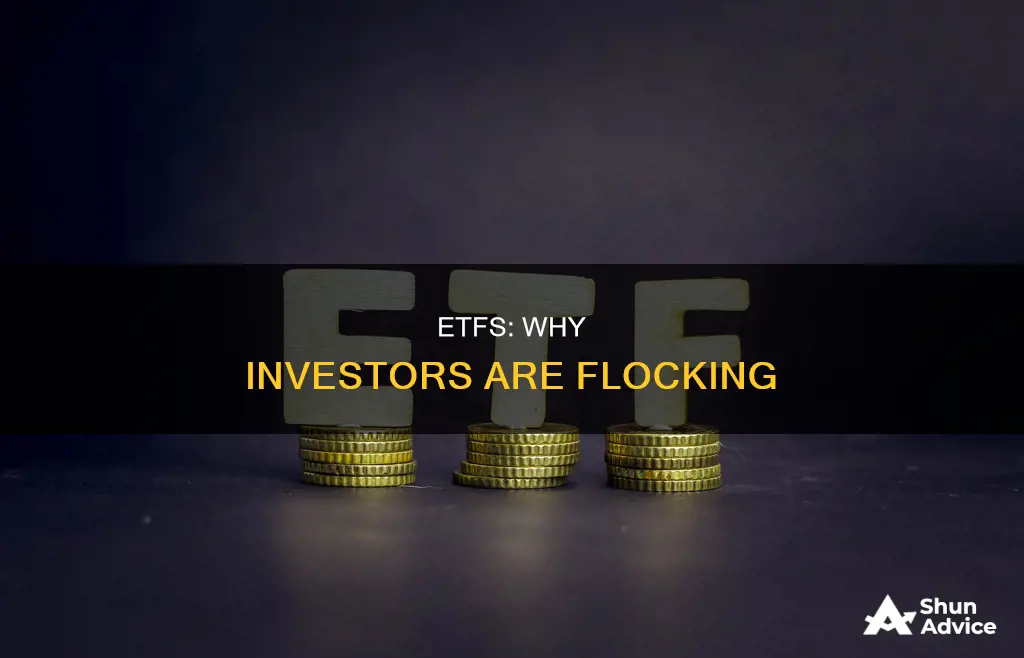
Exchange-traded funds (ETFs) have become an increasingly popular investment vehicle over the past two decades, with total assets under management (AUM) reaching $6.7 trillion in the US and Europe as of December 2022. This growth has been driven by several factors, including their low costs, flexibility, and tax efficiency compared to traditional open-end funds and mutual funds. ETFs offer investors the ability to diversify their portfolios with relatively low investment amounts, providing exposure to various asset classes, industry sectors, and international markets. They also provide trading flexibility, allowing investors to buy and sell during market hours, similar to stocks. Additionally, ETFs are known for having lower expense ratios and reduced capital gains taxes compared to other investment options. The rise of active ETFs, which deviate from their benchmark index and allow investors to pursue differentiated strategies, has further contributed to the growth of the ETF market.
| Characteristics | Values |
|---|---|
| Low-cost | ETFs have lower expense ratios than mutual funds. |
| Diversification | ETFs are considered low-risk investments because they hold a basket of stocks or other securities, increasing diversification. |
| Liquidity | ETFs are highly liquid and can be traded throughout the day. |
| Tax efficiency | ETFs are more tax-efficient than mutual funds. |
| Trading flexibility | ETFs can be bought and sold during market hours. |
| Transparency | ETFs provide greater transparency. |
| Portfolio diversification and risk management | ETFs enable investors to gain exposure to specific sectors, styles, industries, or countries. |
| Investment management choice | ETFs enable investors to manage their investments in the style of their choice, whether that's passive, active, or somewhere in between. |
What You'll Learn

ETFs are more tax-efficient than mutual funds
Exchange-traded funds (ETFs) are considered more tax-efficient than mutual funds. This is mainly due to their structure, which results in fewer "taxable events" and, therefore, fewer opportunities for taxation.
Fewer taxable events
Mutual fund managers need to constantly rebalance the fund by selling securities to accommodate shareholder redemptions or to reallocate assets. The sale of securities within the mutual fund portfolio creates capital gains for the shareholders, even for those with an unrealized loss on the overall mutual fund investment. In contrast, an ETF manager accommodates investment inflows and outflows by creating or redeeming "creation units", which are baskets of assets that approximate the entirety of the ETF investment exposure. As a result, the investor is usually not exposed to capital gains on any individual security in the underlying structure.
Passively managed
The majority of ETFs are passively managed, which creates fewer transactions because the portfolio only changes when there are changes to the underlying index it replicates. Actively managed funds, on the other hand, experience taxable events when selling the assets within them.
Taxable income
Oftentimes, investment advisors may suggest ETFs over mutual funds for investors looking for more tax efficiency. This is because mutual funds typically generate higher capital gains due to the way they're managed, and, therefore, a higher tax bill.
Capital gains distributions
Mutual funds are required to distribute capital gains to shareholders if the manager sells securities for a profit. This distribution amount is made according to the proportion of the holders' investment and is taxable. If other mutual fund holders sell before the date of record, the remaining holders divide up the capital gain and thus pay taxes even if the fund overall went down in value. ETFs, on the other hand, do not have capital gains distributions and so do not incur these taxes.
Tax-exempt characteristics
There are some exemptions to taxation, such as Treasury and municipal securities. As such, an ETF or mutual fund in these areas would have tax-exempt characteristics.
Investing in Startups: Where to Begin?
You may want to see also

ETFs are cheaper than mutual funds
Exchange-traded funds (ETFs) are known to be cheaper than mutual funds. In 2022, the average expense ratio for an index ETF was 0.16% compared to 0.66% for an actively managed mutual fund.
ETFs are often passively managed, meaning they track a preset index of securities rather than having a portfolio manager picking them. On the other hand, mutual funds are actively managed, which means they are trying to beat their benchmark and may charge higher expenses than ETFs.
ETFs are also more tax-efficient than mutual funds. As passively managed portfolios, ETFs tend to realise fewer capital gains than actively managed mutual funds. Mutual funds are required to distribute capital gains to shareholders if the manager sells securities for a profit, and this distribution is taxable.
ETFs also have lower operating costs than mutual funds. This is because ETFs are bought and sold on the open market, so the sale of ETF shares does not require the fund to liquidate its holdings or generate tax implications from capital gains. Mutual funds, on the other hand, are generally bought directly from investment companies, and the sale of shares may require the fund to liquidate its holdings, increasing costs.
Additionally, ETFs do not charge 12b-1 fees, which are advertising, marketing, and distribution costs that a mutual fund passes to its shareholders. Each investor in a mutual fund pays for the fund company to acquire new shareholders.
Overall, the average fees for investors have been declining, and mutual fund companies have been cutting their fees to compete with low-cost ETFs.
Backpack Wheels: Invest in Comfort
You may want to see also

ETFs are flexible and easy to trade
Exchange-traded funds (ETFs) are bought and sold during market hours, offering continuous pricing throughout normal exchange hours. This means that investors know within moments how much they paid to buy and received for selling. This intraday trading makes it easy to move money between specific asset classes, such as stocks, bonds, or commodities.
The trade order flexibility of ETFs gives investors the benefit of making timely investment decisions and placing orders in a variety of ways. Investing in ETF shares has all the trade combinations of investing in common stocks, including limit orders and stop-limit orders and options. ETFs can also be purchased on margin by borrowing money from a broker.
ETFs are also more flexible than traditional open-end mutual funds, which are traded only once per day after the markets close. Investors must wait until the end of the day to know the fund's net asset value (NAV) and the price they paid for new shares or received for shares sold that day.
ETFs are also more flexible than mutual funds in terms of investment thresholds. ETFs tend to have low investing thresholds, so investors don't need a lot of money to get started.
Forging Checks: A Risky Investment Gamble
You may want to see also

ETFs are highly liquid
Exchange-traded funds (ETFs) are highly liquid due to their unique creation and redemption mechanisms, which allow for swift transactions at prices that closely reflect the intrinsic value of the underlying assets. This ensures that investors can easily enter or exit positions without encountering significant price discrepancies or incurring high trading costs.
Primary and Secondary Market Liquidity
The concept of liquidity in ETFs involves both the dealer and secondary markets. In the primary or dealer market, liquidity is facilitated through the creation and redemption mechanisms, which allow for adjusting the ETF's supply to meet investor demand, thus maintaining price stability. The secondary market, or the stock market, refers to the trading volume of the underlying securities in the ETF and their bid-ask spread. A narrower spread often indicates higher liquidity and lower trading costs.
Impact of Liquidity on Trading
Liquidity is crucial for ETFs as it determines how closely the ETF's price tracks its underlying assets. It also impacts trading costs, with highly liquid ETFs allowing for swift transactions that closely reflect the intrinsic value of the underlying assets. This ensures that investors can buy or sell without significantly affecting the price.
Factors Influencing ETF Liquidity
The primary factors influencing ETF liquidity are its composition and the trading volume of its constituent securities. Secondary factors include the ETF's trading volume and the investment environment. Even low-volume ETFs can exhibit high liquidity if they track a liquid index or sector and have active authorised participants (APs) facilitating the creation and redemption process.
Advantages of ETF Liquidity
The liquidity of ETFs provides several advantages for investors. It enables timely investment decisions and a variety of trade combinations, such as limit orders, stop-limit orders, and options. ETFs can also be purchased on margin and sold short. Additionally, the intraday trading of ETF shares makes it easy to move money between specific asset classes, such as stocks, bonds, or commodities.
Mutual of America: Worth the Investment?
You may want to see also

ETFs are low-risk
ETFs: A Low-Risk Investment Option
Since their introduction in 1993, exchange-traded funds (ETFs) have become increasingly popular with investors due to their low-risk nature. Here are several reasons why ETFs are considered a low-risk investment option:
Low Costs and Diversification:
ETFs are known for their low expense ratios compared to other investment vehicles, such as actively managed funds. The low costs are partly due to the streamlined operating expenses of ETFs, as certain client service-related expenses are passed on to brokerage firms. Additionally, ETFs do not charge a 12b-1 fee, which is an annual marketing fee typically incurred by other investment funds. This makes ETFs an ideal type of asset for individual investors to build a diversified portfolio.
Tax Efficiency:
ETFs are often more tax-efficient than mutual funds due to their passive management structure. They tend to realise fewer capital gains, resulting in lower capital gains taxes for investors. In the case of ETFs, capital gains taxes are incurred only when the investor sells the ETF, whereas mutual funds may distribute capital gains taxes throughout the life of the investment.
Reinvestment of Dividends:
ETFs offer the option to immediately reinvest dividends, allowing for potential growth in the investment. This feature is particularly attractive to long-term investors.
Liquidity and Transparency:
ETFs are bought and sold during market hours, providing continuous pricing throughout the trading day. This liquidity gives investors greater flexibility and control over their investments. Additionally, the pricing of ETF shares is transparent, as it is based on the changing intraday value of the underlying assets in the fund.
Reduced Risk Through Broad Exposure:
ETFs provide investors with exposure to a diverse range of asset classes, industry sectors, and international markets. By investing in an ETF, individuals can gain access to a basket of stocks or securities, reducing the risk associated with investing in individual stocks.
While ETFs offer numerous benefits, it is important to remember that they are not completely risk-free. There are certain unique risks associated with ETFs, such as tax considerations, lack of diversification in certain niche ETFs, and the potential for large swings in value, especially in more specialised ETFs. However, overall, ETFs are considered a low-risk investment option, making them a popular choice for investors seeking to balance risk and return.
Invest Wisely in People, Shape Your Legacy
You may want to see also
Frequently asked questions
Exchange-traded funds (ETFs) offer investment opportunities for young people with relatively small amounts of capital and a basic knowledge of investing. There are thousands of ETFs to choose from, allowing investors to participate in a wide variety of markets. ETFs are highly liquid and can be traded throughout the day, and many have low-cost structures.
ETFs have several advantages over mutual funds, including lower operating costs, flexible trading, greater transparency, and better tax efficiency. ETFs also offer trading flexibility, portfolio diversification, and lower costs compared to mutual funds. Additionally, ETFs are bought and sold during market hours, providing investors with greater control over their investments.
There are three main reasons for the increasing popularity of ETFs: tax efficiency, lower costs, and the misconception that ETFs are synonymous with passive investing. ETFs are generally more tax-efficient than mutual funds, allowing investors to control when they take capital gains. They also tend to have lower costs, which is an attractive feature for price-conscious investors. Finally, the common misconception that ETFs are only for passive investing has contributed to their popularity, as passive investing has gained traction.







